|
2/11/96
(Saturday) |
|
|
Arrived in
Greece about 5 am local time. It being so early I thought it would be best
if I just kept on moving, so decided to fly on to Crete. I caught a taxi
to the 'Western Terminal Air Olympic' which I understand handles all the
internal flights. Before we started there seemed to be some confusion on
the part of the taxi driver: he kept asking 'what flight is that?' which
didn't appear to be relevant to his getting me to the terminal at all.
Also his chum who had been standing beside him chatting - and who had
watched me walking down the steps and through the carpark towards the only
taxi on the rank without moving - suddenly grabbed my bags while the
driver and I were still talking and put them in the boot. Then he started
shaking his hand for a tip. This was a bit annoying but, not being aware
of customs, I gave him the benefit of the doubt and about 200 drachmas.
Having arrived
at the airport I then had to buy a ticket, and the system they use is most
strange. First you buy a ticket and then you move to a cashier (?, who
does what? I don't know.) and then you go back - against the flow of
customers - to the first counter to get an acknowledgement that you've
been to the second one. And all this time there there are crowds of people
who try to push in front of you, even when you're talking to the counter
staff. I had to actually push people away just to stop them pushing me
aside! A complete shemozzle.
Arrived in
IRAKLION.
And was quite at
a loss to know what to do next. I tried to get a taxi to a luggage deposit
that was listed (surely I'm misreading the guidebook) as at a bus station.
This resulted first in a scrum of taxi drivers and camp followers all
puzzling over the map (they didn't seem to recognise the city!), and
second in my being taken to a standard bus stop in the middle of nowhere.
So I just said 'take me to 25 Avgoústou'
, the main street, which he could handle quite well. That all cost only a
trifle (2000 drachmas) so it was only time and effort that was wasted.
(The first taxi had cost 5000 D. and I thought I might have been trivially
cheated, but the guide says that 's the standard fare between terminals.
Don't be paranoid.)
There's a youth
hostel on Vironos street (Lordou BuronoV
- Lord Byron) a bit off 25 Av. and I left my bags there while I searched
for a hotel. I quite quickly found one on Dedalou that had a decent room
available for just 6 kD ($NZ50).
|
|
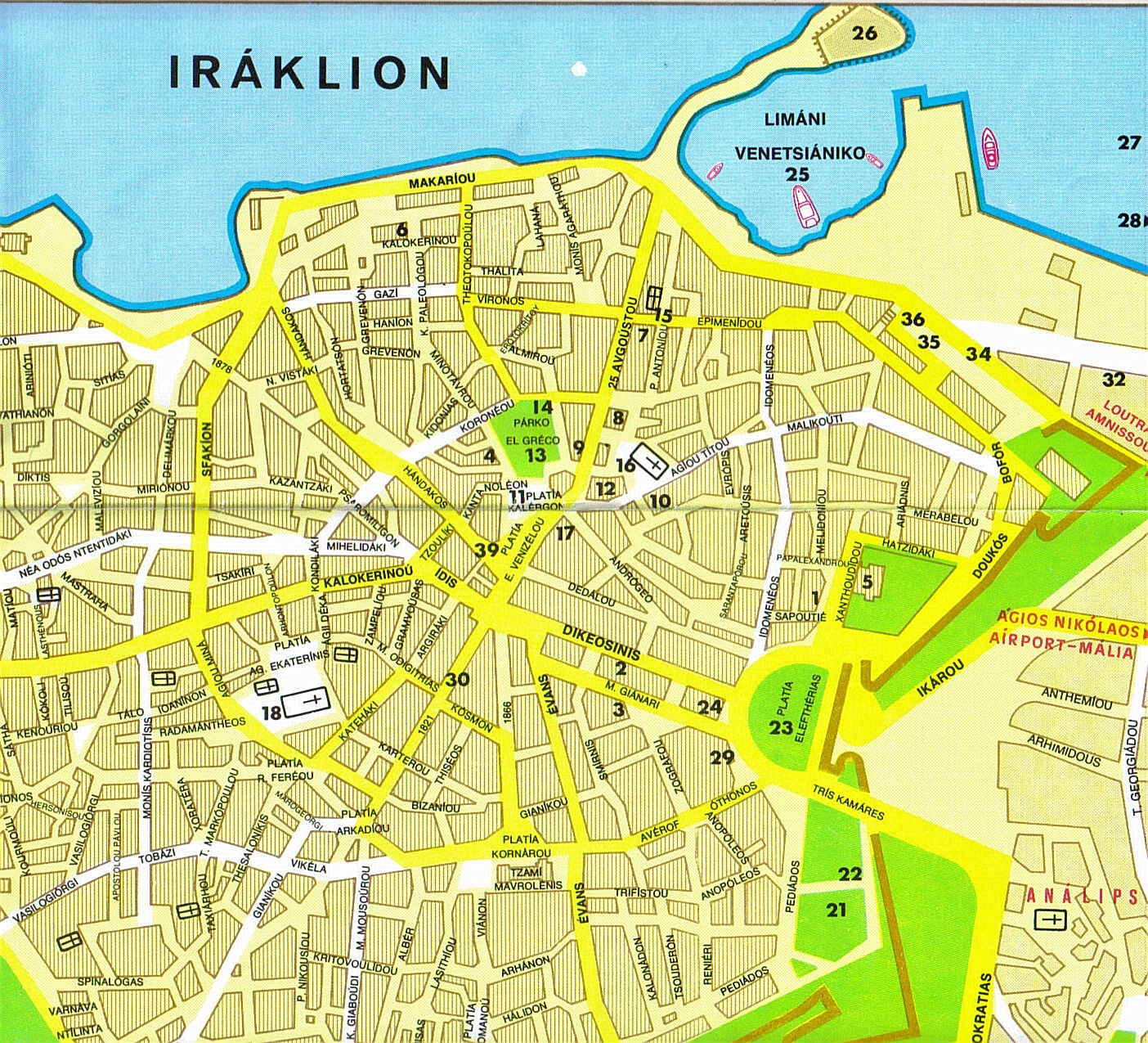 |
|
Map of
Iraklion
Formerly
known as Candia. Airport to East, Big bus station to West, my hotel almost
exactly at the centre. |
|
Since there was
still plenty of day left I got onto a bus and went out to see Knossos.
I was lucky that the driver was looking out for me, because I was admiring
the scenery as we drove along and didn't see the stop for the ruins. He
very kindly stopped and called my attention to it.
|
|
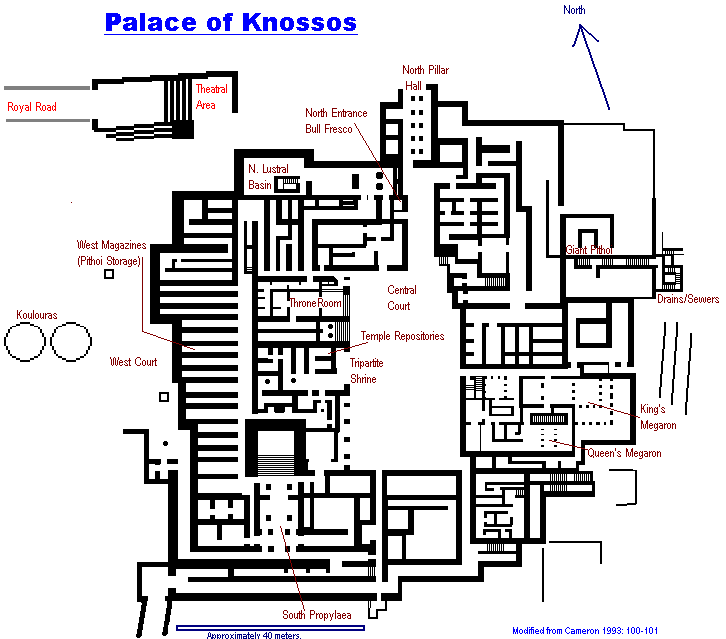 |
| Map of Knossos |
|
Knossos
was amazing. I'm very grateful to Evans for the partial reconstruction
work, which, even when it's a bit inaccurate (as I'm told the main palace
part is) still gives you a much better idea of the original splendour that
you'd get otherwise. It was an exciting experience walking along the Royal
Road. One thing made me especially curious: many of the small rooms don't
seem to have entrances or exits. How were they accessed? By ladder?
|
|
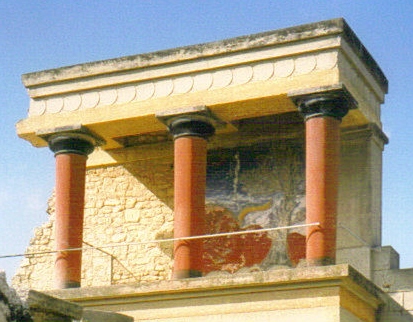 |
|
The Bull Portico
I tried to include a picture of the nifty drainage works in the bottom
of this picture but it turned out too dark. They're a series of terracotta
half pipes with baffles, etc. Really very impressive for an ancient site.
Comparable to Harappa.
|
|
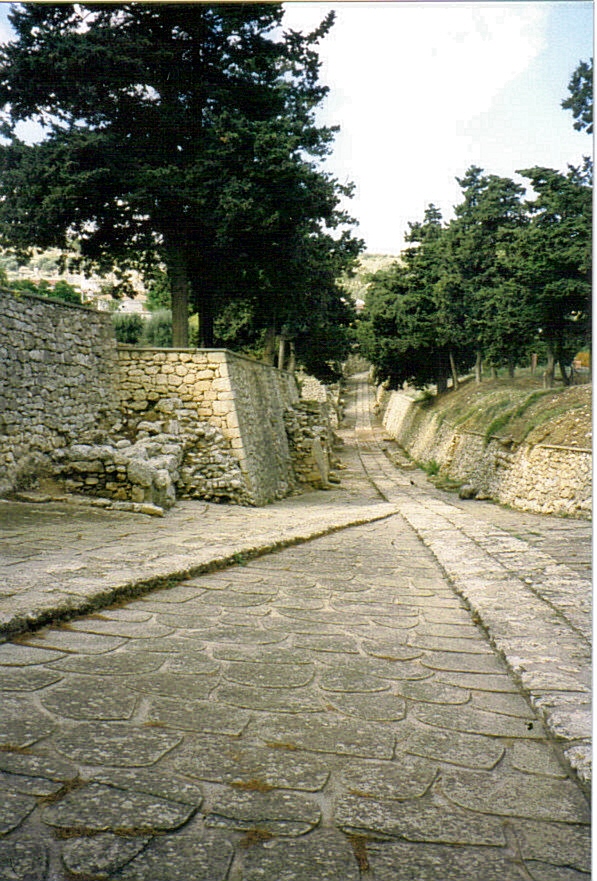 |
|
The Royal Road at Knossos
The oldest road in Europe: about 4500 years old. Leads away
from the 'Theatral Area' . There's a small modern shopping centre
cunningly hidden behind those trees at the end of the road (which ends in
a brick wall.)
|
|
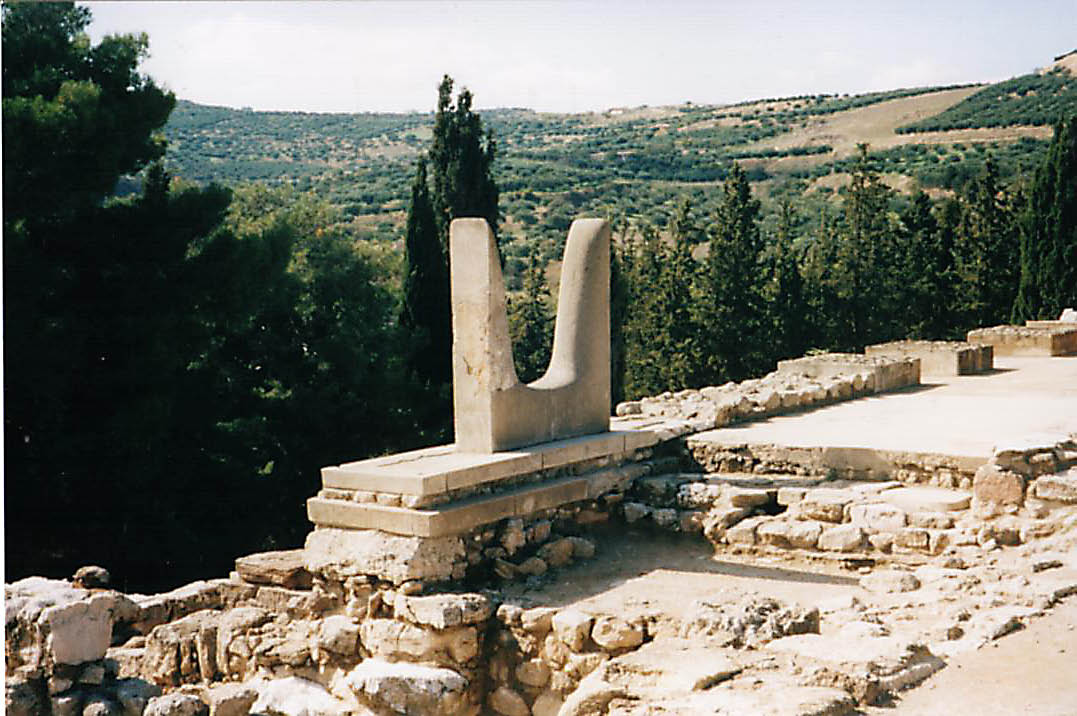 |
|
Knossos: Horns of Consecration
The most
comon religious symbol of the Minoan (Keftiu) civilization. They're
obviously bull-related but they also seem to be related to the double axe
(labrys). What their fundamental significance is is mysterious. Some say
that these large examples are directed at significant features of the
landscape: Mount Juktas can be seen through this one, for example.
|
|
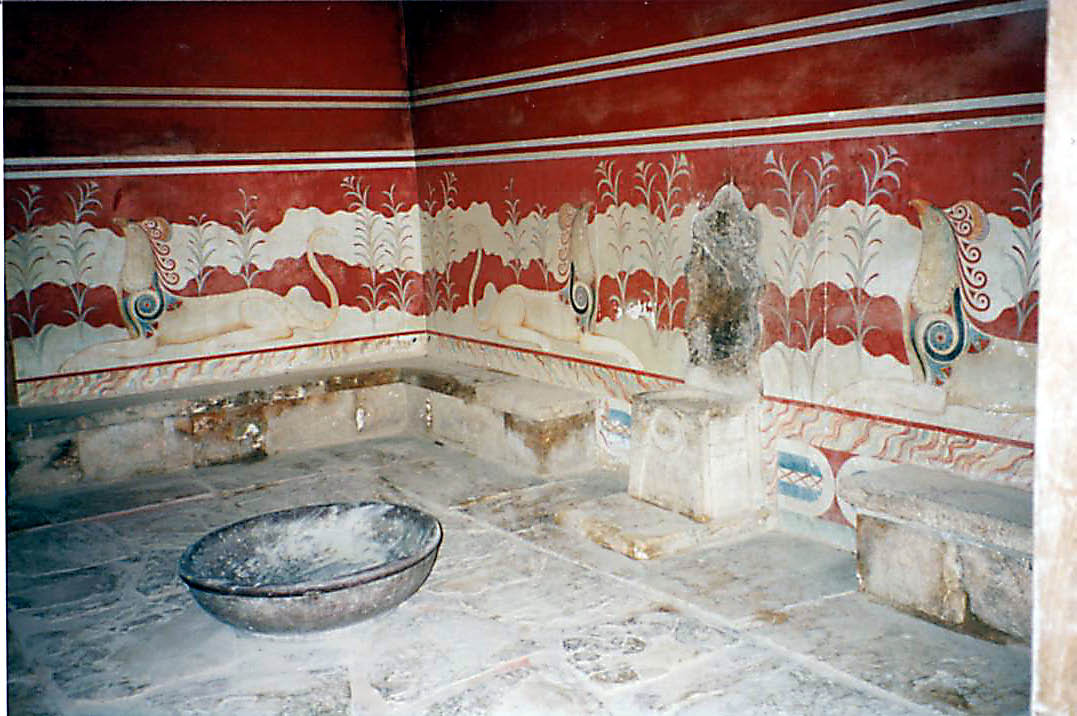 |
|
Knossos Throne Room
Some sort of
lustral basin in the middle
|
|
I got back in
plenty of time too, so I took the opportunity to round the day off with a
visit to the archaeological museum. This was almost as much fun as
Knossos itself. There were Minoan frescoes, pottery, lots of labryses,
Linear A tablets, and Mycenaean boars tusk helmets. I saw the Phaestos
disc, the double bee pendant, the 'King' fresco, the 'Parisienne', the
bull's head rhyton, the snake goddess figurines. Wow. All that stuff I'd
only ever seen in photographs. There were some oddities though. For
example, the funerary bath paintings show the labrys mounted inside the
horns of consecration. I don't think I've ever seen that before. I have
seen the double-bowled pots before, but in real life they prompt the
question: why would anyone want to make such an inconvenient pot?
And what, really, is the meaning of those pushme-pullyou animals?
|
|
3/11/1996<˙˙˙˙/p>
(Sunday) |
|
|
Didn't get as
much done today as I thought I would. I had breakfast outside at a
restaurant in Platia E. Venizélou just up the road from my place:
bacon and eggs and good coffee. An English breakfast, as I believe they
described it. This is the only way to start a day. Spent the time writing
postcards to family and friends. My postcard to Sharyn was a picture of
some idyllic Aegean island scene which I inscribed 'Ha ha ha ha ha ...'
Her parents found that amusing - but, of course, she didn't.
|
|
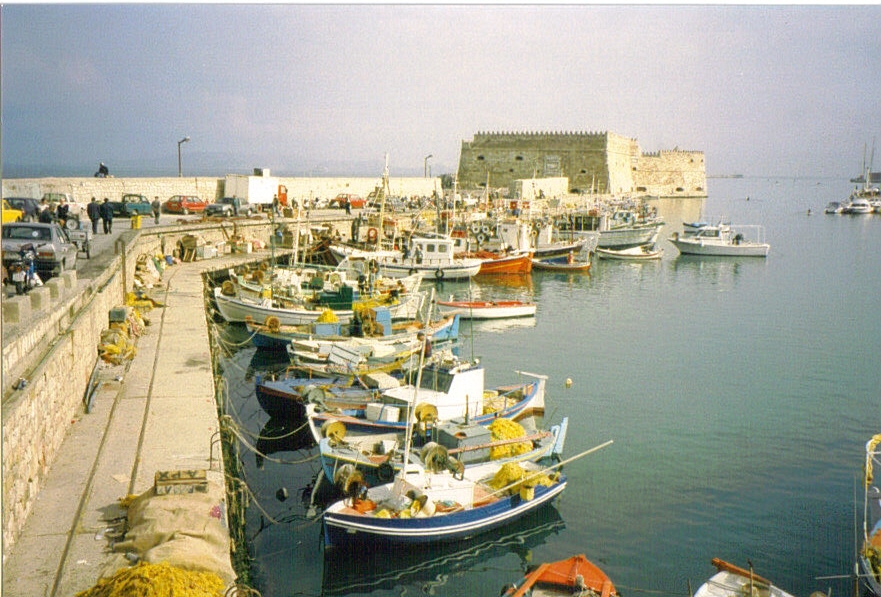 |
| Venetian Harbour |
|
When I'd
finished this very leisurely breakfast I went for a walk along the
waterfront. It was picturesque in parts - especially the old harbour with
the Venetian fortifications at the end of the quay, and all the fishing
boats lined up and preparing to go out - but in other parts it had been
rather spoiled by modern industrial brutalist additions. Wandering around
the backstreets of the Western parts of Iraklion didn't add much to my
store of memories of beautiful things.
Eventually I
made my way out to the South/West Bus Station and caught a bus out to
Phaestos.
|
|
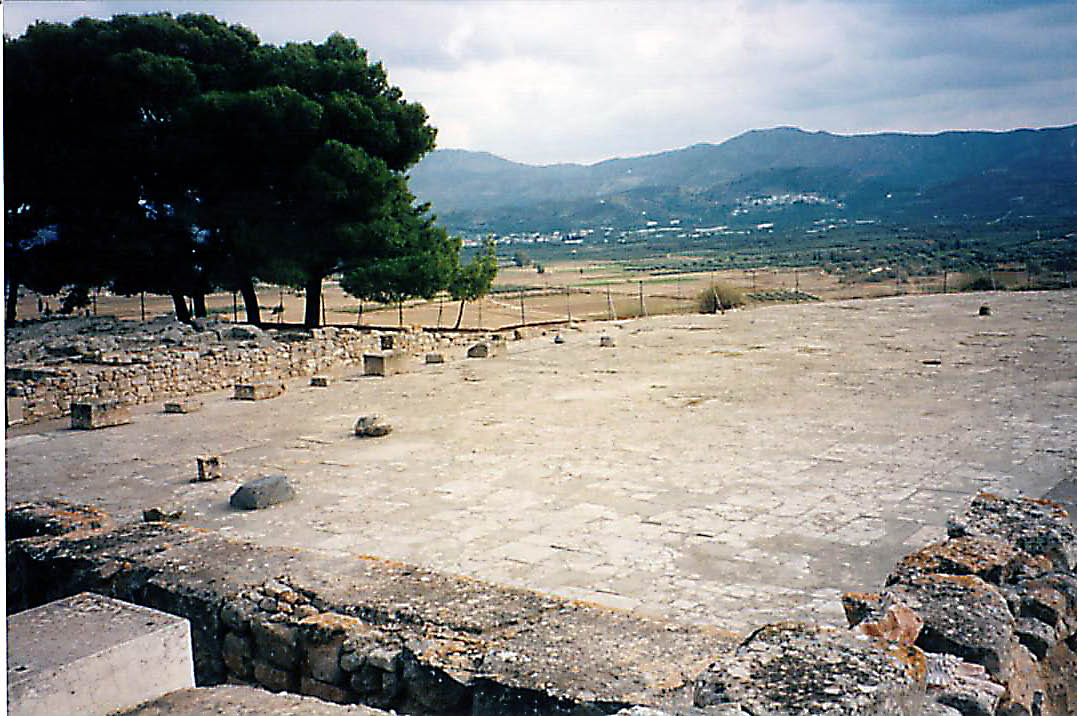 |
|
Phaestos
The central
courtyard of the Palace of Phaestos. The 'Prince's Rooms' are at left.
|
|
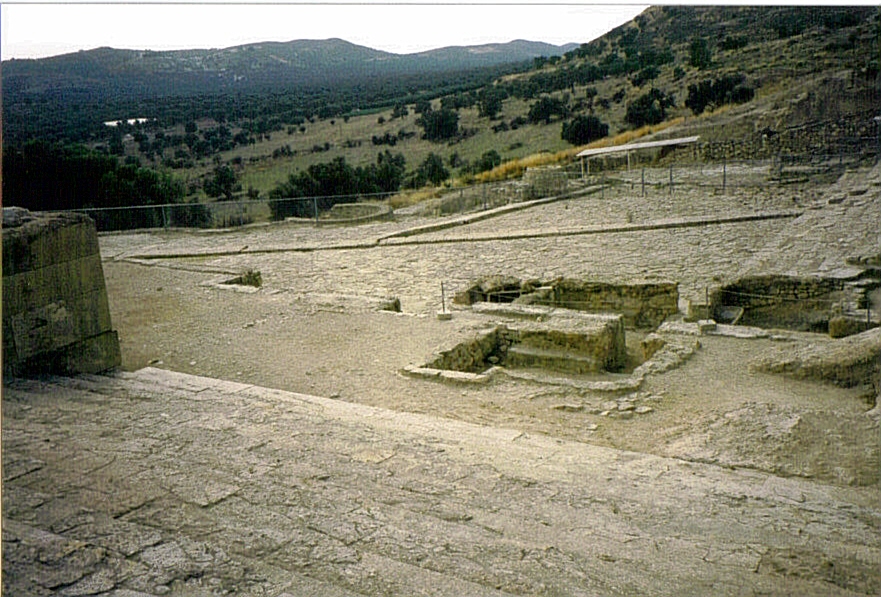 |
|
Phaestos
The Palace of
Phaestos. From the propylaeon looking down the Grand Staircase to the
Theatral Area and West Court. The circular structures at the edge are the
storage pits..
|
|
It certainly
struck me here how much the appreciation of this site depended upon my
being able to impose Evans Knossos reconstructions upon it. On the
other hand I seemed to have the worst trouble trying to reconcile the site
map in the guide to the 'facts on the ground.' But that's a trivial
difficulty. The view from the palace rooms must have been wonderful,
especially when the farming was in full swing and they could also look out
over a small town - wherever that was - supporting the palace.
I rather regret
that I'd given myself so little time to see Greece. It means that I wasn't
able to take the time to see Hagia Triada or Mallia as I'd
intended. I had tried to arrange a trip to Delos (via the appalling
tourist hell of Mykonos) or Thera/Santorini, but the
transport available in the tourism 'off season' is so limited that it
would have taken about three days to make those connections, and I just
can't afford that much delay. So I decided to head straight back to
Athens, but I'd get some accommodation at the same time by taking an
overnight ferry across.
The ferry was
nice. I booked a single, but that's just a double bunk cabin with one
empty bunk. I think I upset the porter because I refused to give him a
tip. To board the ferry one walks up the gangway and then negotiates steps
and corridors to get to the cashier's desk in the middle of the ship. At
that point - ie. after all the hard work had been done - the porter
grabbed my cases, while I was still getting keys from the cashier and
after my specifically saying not to take the bags - and started walking
off to take them just round the corner. No more than 20 metres. It was a
repeat of the taxi-driver's chum's non-helping: but this time I wasn't
going to reward their laziness, so I said thanks and shut the door while
he was offering his open palm to me. Tough for him. Next time meet your
clients at the gangway and earn your money.
|
|
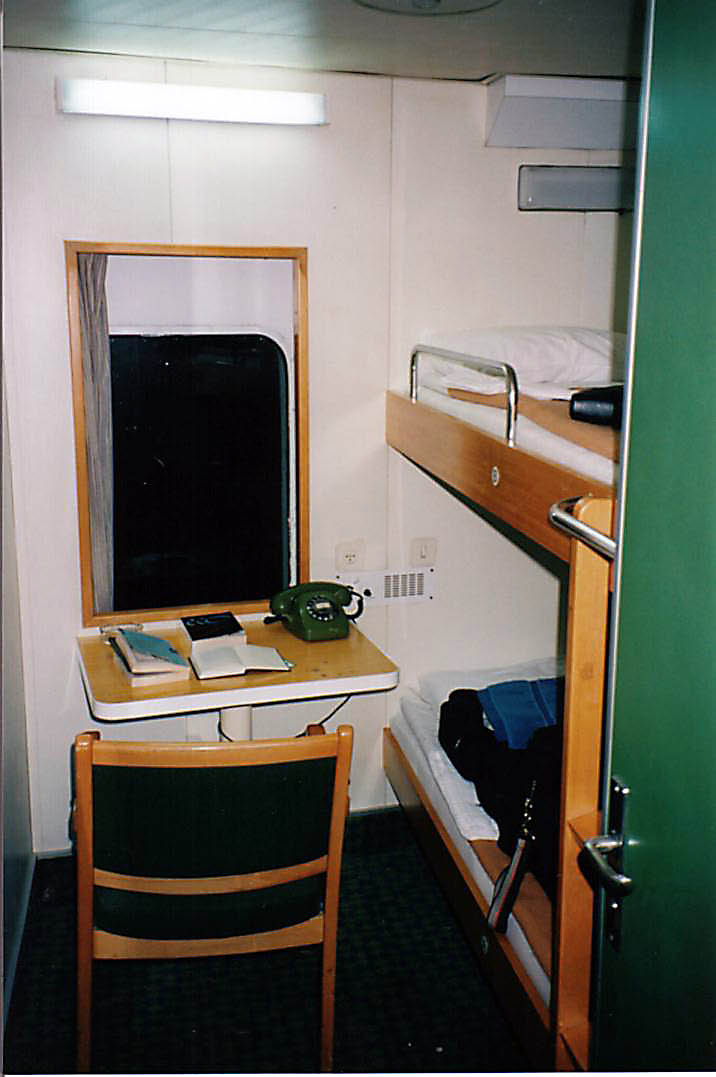 |
|
Ferry cabin
From Iraklion to Piraeus
|
|
4/11/1996
(Monday) |
|
|
The ferry did
not provide a restful environment. The noise was such that I couldn't get
to sleep until about 5 am. And I had to wake up again almost immediately
anyway because we'd arrived. Clearly it is only a 10˝ hour trip and not a
12˝ hour one as the guide described it. Thus I arrived in the dark in
Piraeus (the port of Athens, but a separate city.) My first
concern was to drop off my bags, but that turned out not to be possible.
There was a railway station somewhere around here, I knew, but it
certainly wasn't obvious how to get to it. I wound up lugging bags along
broken footpaths and across tracks to get to it. And when I did there were
no signs to tell me where I was and there was no luggage store anyway. So
I headed off to another station - I guessed I was at the 'Northern'
station - but this was also unmarked and had no store. By this stage I was
fed up so I went outside that station and sat on the bags for a while
thinking about what to do.
At this point I
was approached by 'John', an Englishman who was working as a tout for
travel agencies. He advised me to go to Iokasta Tours. (I love these names
- why would anyone want to be associated with Oedipus' mother? Anyway, I
didn't see any reason why this wasn't as good an option as any other, so I
took a hair-raising taxi ride in to town. (As John said, Greece is the 3rd
world, it's only modern on paper.)
Arrived in
ATHENS.
I hired a little
Fiat Cinquecento for 3 days for about 37 kD ($NZ180). Actually getting out
of town was a bit of an effort: the roads are nowhere near as well marked
as the roads in Italy, and they're all in Greek script which it takes just
a little bit long to read so that I've driven past the road by the time
I've worked out what it is. At the same time I was trying to get used to a
new left hand drive car (first time ever) and new road rules. Luckily it
wasn't peak hour, but it was still busy enough. Eventually I did escape,
however, and headed up highway 1. Rather nice main roads in Greece.
|
|
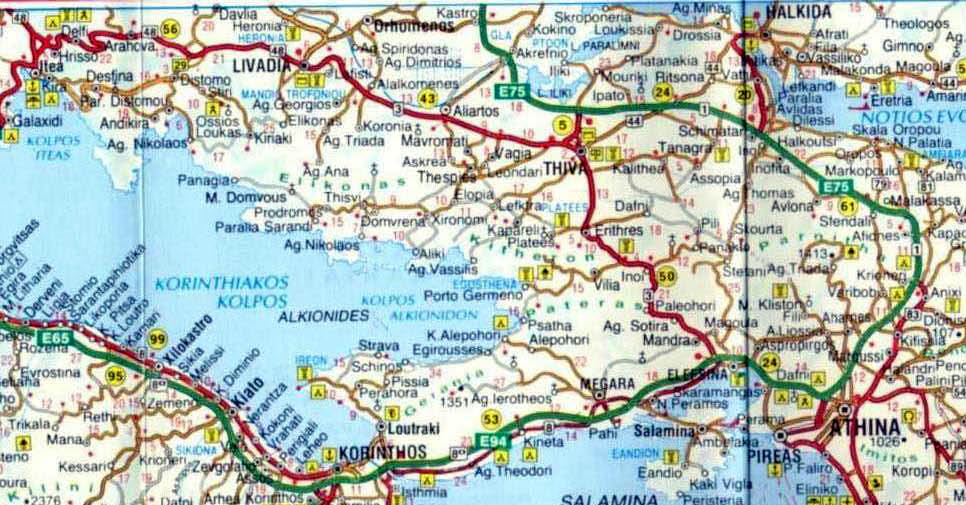 |
|
Road Map: Athens to Delphi
|
|
Driving through Thessaly my impression was that it was about as
fertile as the Central North Island; ie. not very. It seemed awfully dry
and sparsely covered.
My
first objective was to find the ancient Mycenaean citadel of Gla. It's a
little bit off the beaten track, but I thought I had fairly explicit
directions to it. It's off highway E75 near the town of Kastro
(very top of the map shown). Well, I tried for ages to make sense of the
directions until I eventually wound up in a rhubarb patch at the end of a
farm road. At that point I started reflecting to myself (in heated terms)
that the Mycenaeans weren't going to put a citadel in a rhubarb patch;
they're much more likely to put it on top of a hill ... like that one over
there, for example... Oh... Yes, I'd been driving around looking
only at the directions and the road and hadn't thought to look up and see
the very obvious Mycenaeean citadel down the road a bit. Very
embarrassing.
Gla
was huge. Far too big to walk all over. And they say there are snakes. I
walked along the walls quite a bit, but most of the interior was still
unexcavated, so there wasn't too much to see in there. And it was also
pretty rough and overgrown. It was still pretty impressive walking about
such a place, which from the size must have been of supreme importance,
but of which no one knew anything. Very Ozymandian.
|
|
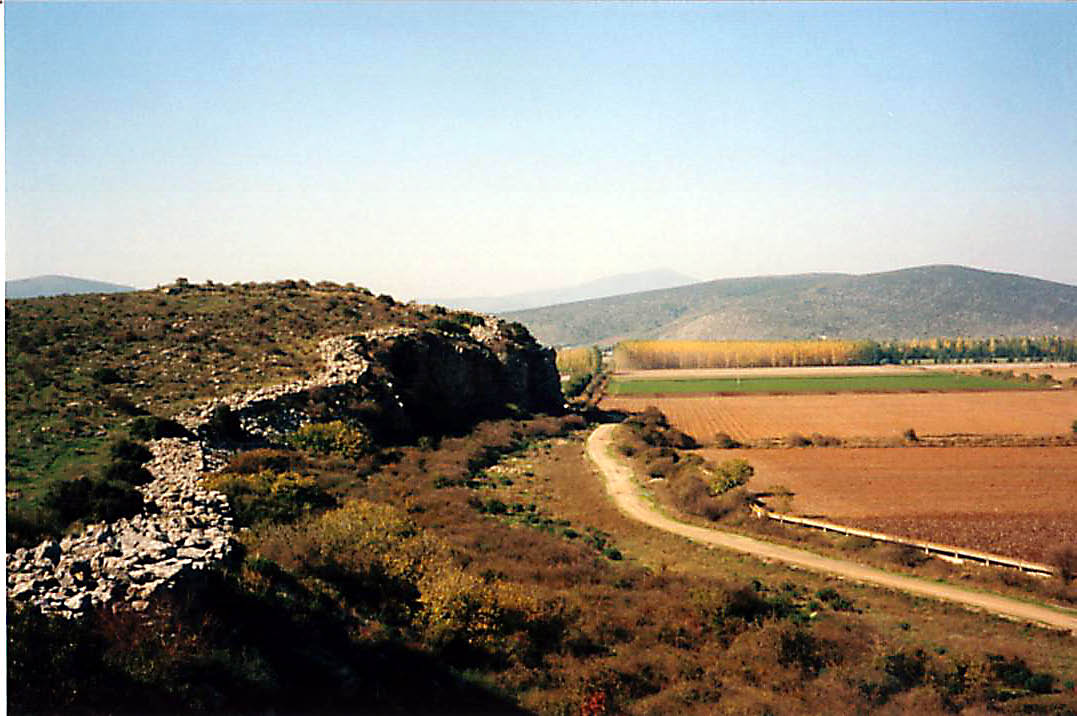 |
|
The citadel of Gla
A Mycenaean
site. Formerly located upon an island in the middle of lake Copaďs.
|
|
Drove through Orchomenos, the city of the Minyans, originally on
the shores of the Copaic lake. Nothing much remains there. I was not
detained by its charms, for it had none.
|
|
 |
| Away from Arahova |
|
By
contrast , I was very much taken by the picturesque town of Arahova
which I'd merely been driving through. I rather think that I would have
enjoyed stopping here for a time, but, again, I had no time for it. I was
heading for Delphi, and I was eager to see that sacred spot.
|
|
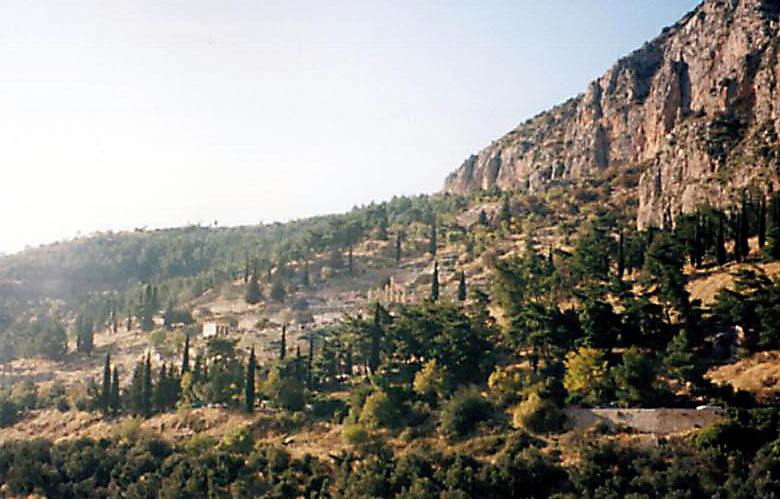 |
|
Towards Delphi
A view of the
ancient pile of Delphi. Mount Parnassos is to the right. The
temple is that of the Treasury of the Athenians and the columns belong to
the Temple of Apollo.
|
|
Delphi was everything that I'd expected. I recall Kenneth Clark once said
that some places like Iona and Delphi always seemed to be sensibly
spiritual places. I understand what he intends by this, even if one has
not a spiritual bone in one's body, one can't help but be aware of the
atmosphere in the place - an atmosphere of awareness that perhaps drew the
early worshippers here, or perhaps is due to the awareness one has of the
site's role in history.
|
|
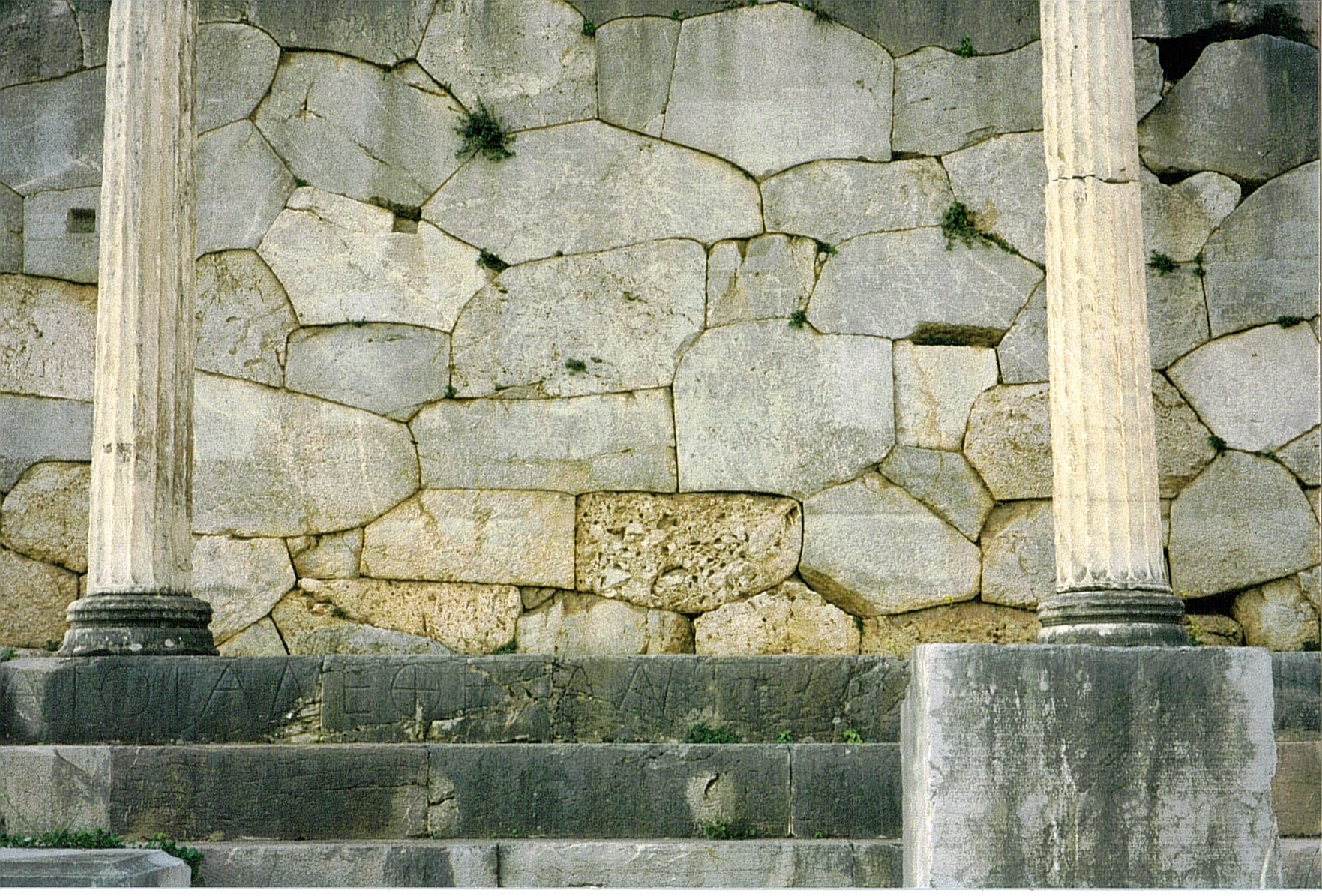 |
|
The Polygonal Wall
There are
inscriptions in various scripts on the base of the column to right and on
the risers of the steps. The inscriptions relate to the emancipation of
slaves.
|
|
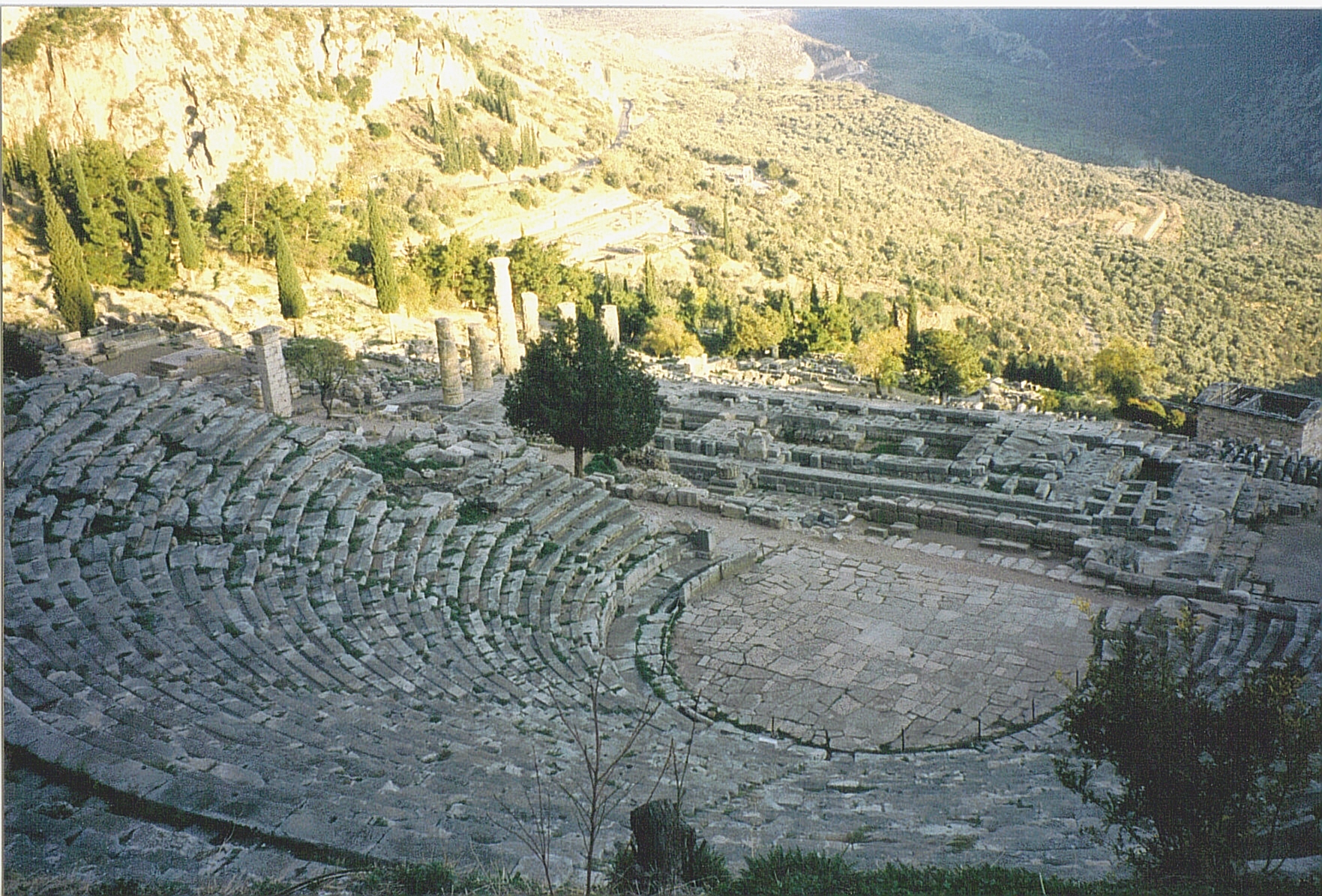 |
|
The Theatre at Delphi
Looking down
into the valley over the Temple of Apollo. To the right is the Treasury of
the Athenians.
|
|
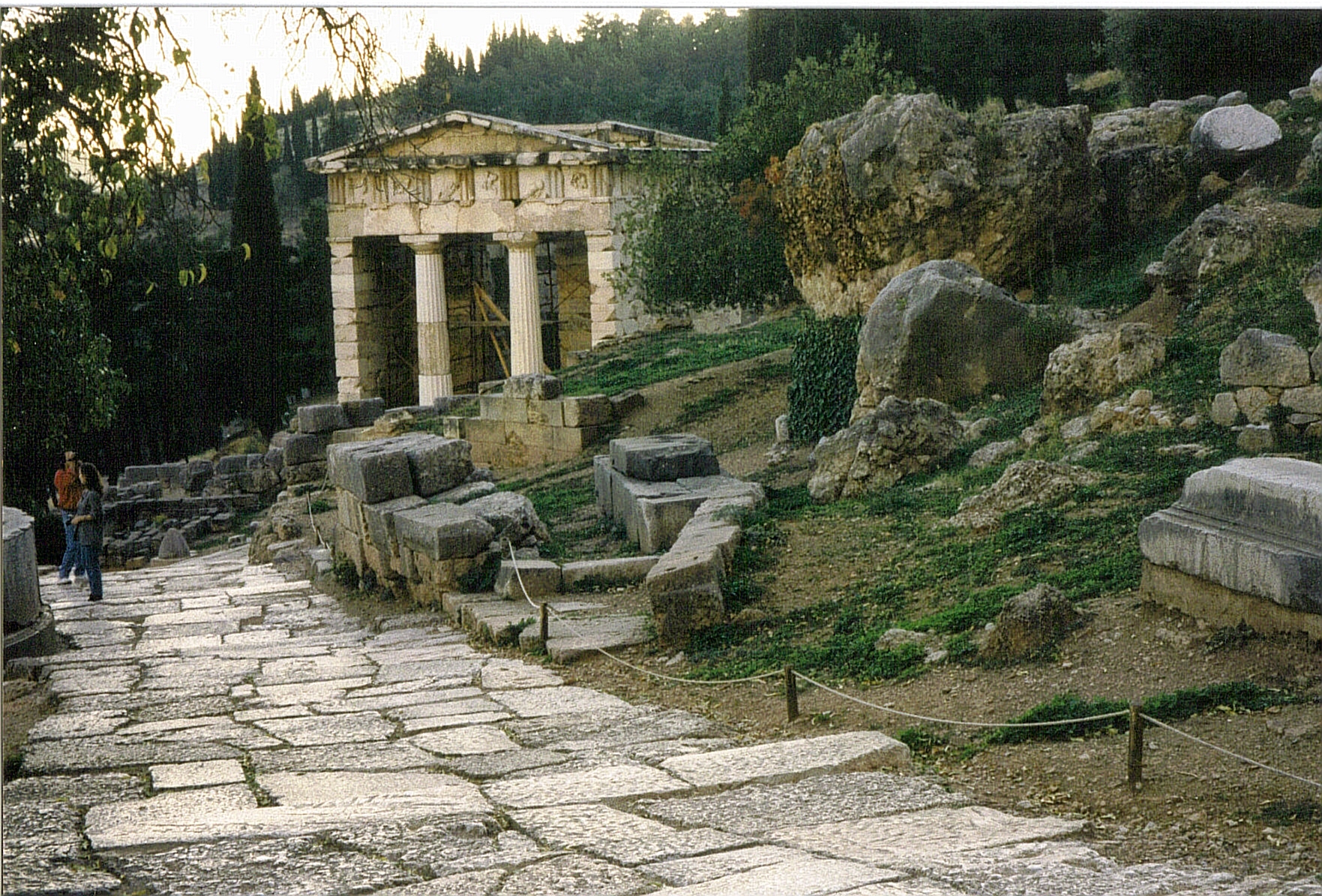 |
|
The Sacred Way at Delphi
Looking down
the Sacred Way to the Treasury of the Athenians. The rock to the centre
right was the sanctuary of Gea and from it the Sibyl prophesied.
This is the omphalos, the centre of the world.
|
|
I
took my time in Delphi. And when I'd finished I returned to the
small modern town of Delphi and took myself a rather expensive room
in quite a nice hotel. Not my usual choice of accommodation. It has
amazing views down the vally. For dinner I went into town and found a
small place that was open quite late. I asked for a chicken and salad;
when it came there was plenty of it but it wasn't very good. Half a
chicken, very indifferently cooked, and a huge bowl of 'salad' which
seemed to be swimming in about half an inch of olive oil. (That's an
exaggeration, but not by much.)
|
|
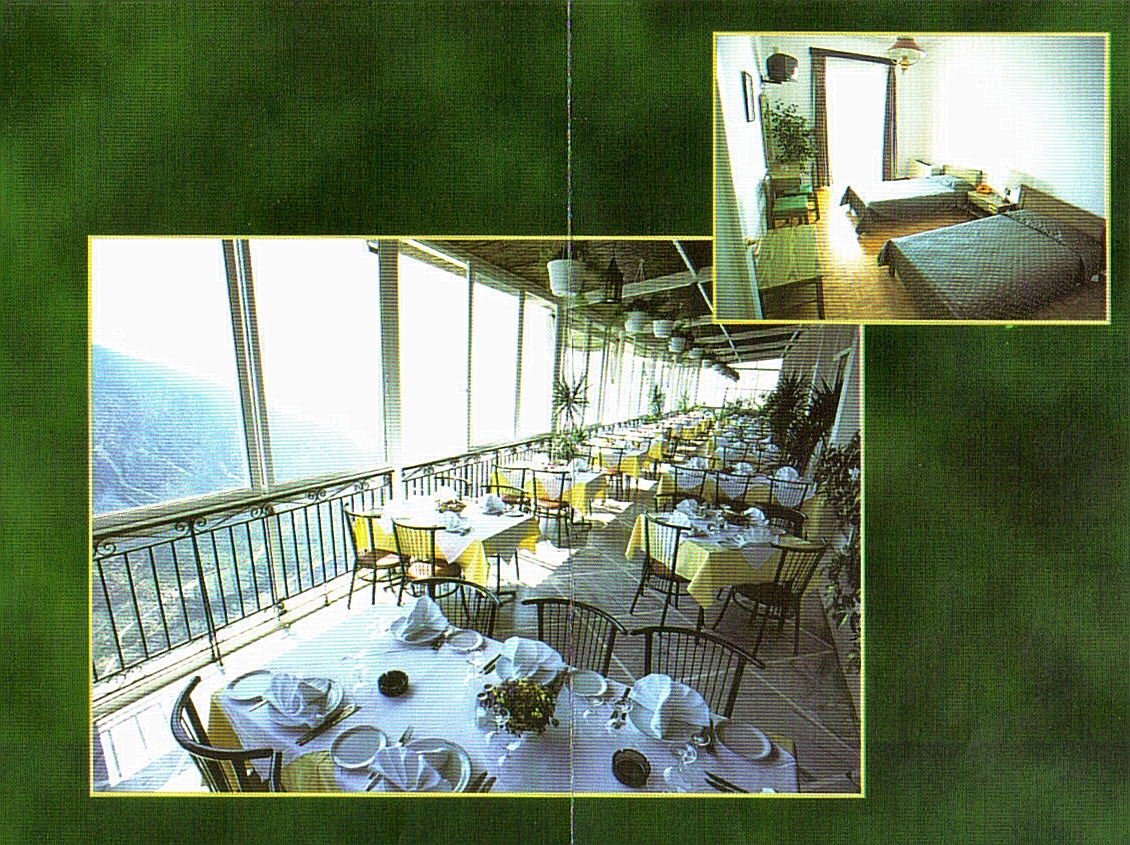 |
|
Hotel Vouzas
From the
hotel pamphlet. My room was exactly as shown, except without a plant.
There's a little balcony attached too, with a nice little table and chairs
at which to sit.
|
|
5/11/1996
(Tuesday) |
|
|
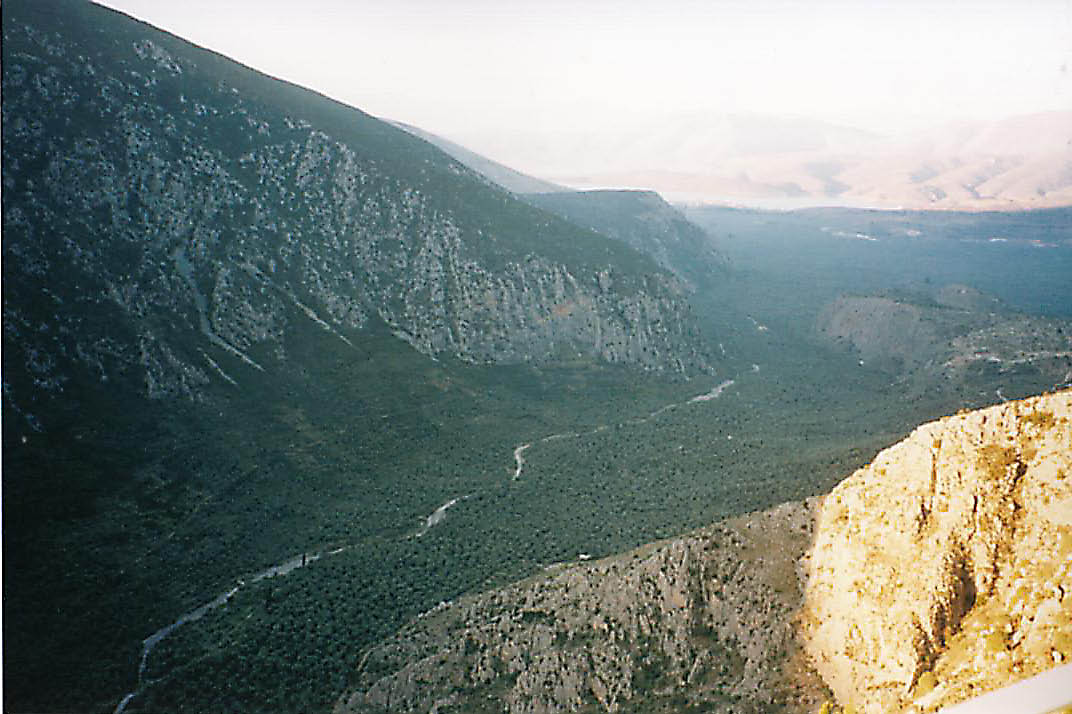 |
|
The morning view from my balcony
The Gulf of
Corinth can just be seen at the top. In the morning the air is very still
and clear and cool and you can hear the goat bells tinkling. |
|
I
woke up early enough today but it was such a pleasant room and such a
great view from it and from the restaurant that I stayed until after 10:15
just reading and having breakfast and lounging. Eventually, however, I did
tootle off and headed for the ferry at Andirio, just past
Naupactis.
|
|
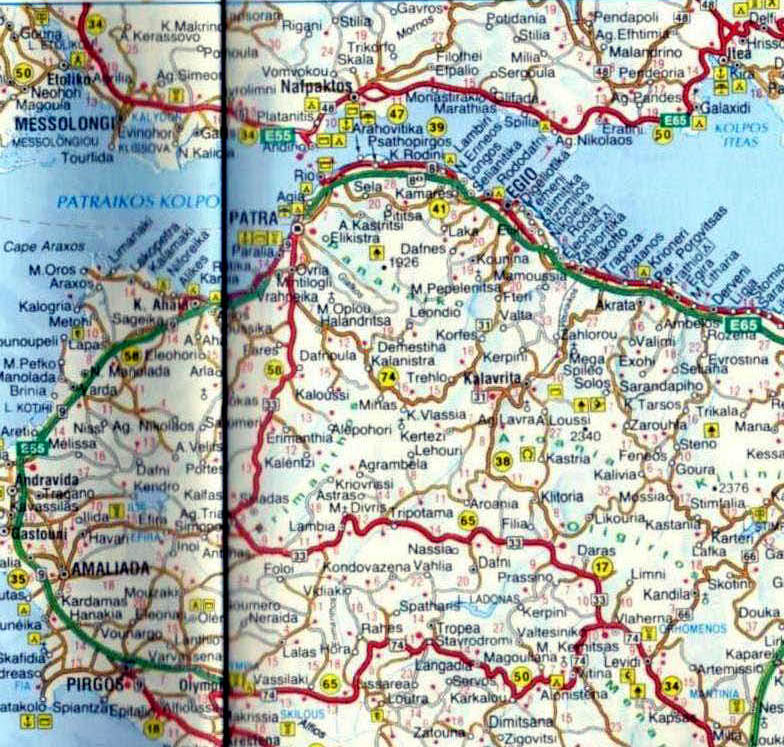 |
| Road Map: Delphi to Langadhia |
|
The
road to it was excellent and largely unused, and it gave spectacular views
of the Gulf of Corinth. I would have been happy to stop and swim at one of
the lonely little beaches that I could see from the road down the coastal
slope, but there didn't seem to be any way to get to them.
There's obviously some problem with falling rocks from the cliffs above
the road. At one point I had to stop while workers were attending to an
active slip. The first time they waved me on I mucked about a bit putting
my map away and thus avoided being struck by rock which just then shot
across the road. There were some quite impressive tunnel-like
concret covers over the road in some places, and there are miles-long
stretches where the cliff sides were covered in netting. Very interesting.
|
|
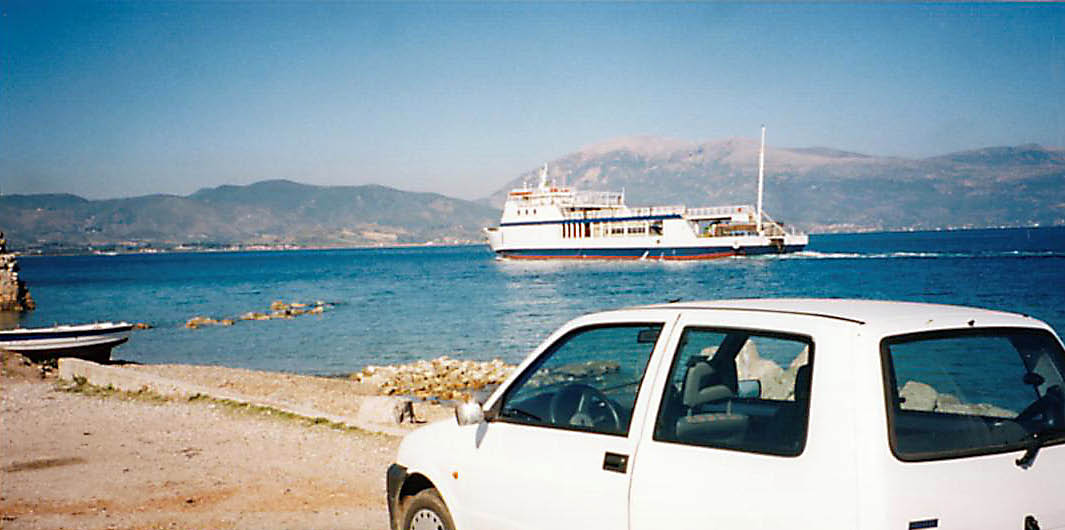 |
|
Car Ferry
My car and
the ferry it rode in on. I have just crossed the Gulf of Corinth. |
|
The
ferry ride from above to below was quite painless; even pleasant, and
blessedly brief. From Rio the road to Olympia is OK but dull.
Olympia itself surprises with the pleasantness of its environs. The
ruins are dotted and enclosed by plane trees. It looks like a great place
for a picnic.
|
|
 |
|
The Palaestra at Olympia
Formerly a
wrestling school.
|
|
 |
| The Stadium at Olympia |
|
As
I was walking about the stadium - very nice - I was hailed by a guard who
was just being friendly. I suppose it gets pretty boring around here in
the off-season. We sat and talked after a fashion for a little while. He
offered me a cigarette which I had to decline. He pointed out the course
of the 'sacred river Alph', the Alpheus (or one of them anyway,)
which runs just behind the olympic site. It's surprising how much one can
communicate even when there is no common language.
The
ruins are impressive - and even more melancholic than usual - and would be
even better if, as the guide suggests, some restoration work were done on
them. I also visited the Museum, which has two outstanding pieces: the
'Hermes' of Praxiteles, and the 'Nike Descending' by Paionos. The first I
found more affecting than all but the best of Michelangelo's work.
|
|
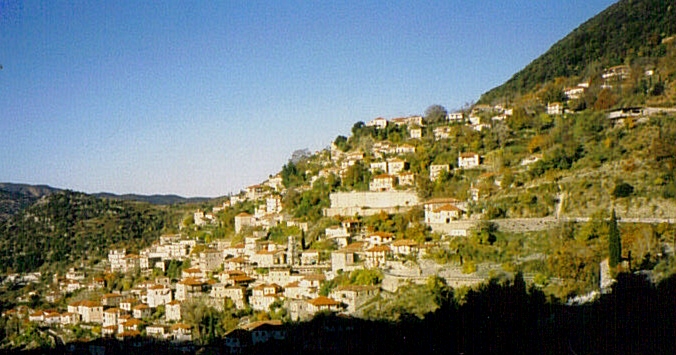 |
| Langadhia |
|
It was obviously
too late to go to sandy Pylos, where I had hoped to see the site of
Nestor's kingdom, the hearth in the palace, and perhaps some displays of
Linear B tablets. InsteadI headed East across the mountains of Thessaly. I
found that the road was a narrow, winding, hilly, 'back' road, and it got
dark long before I'd got very far. I began to worry about where I would
spend the night because the villages I was passing through were very small
and had no hotels that I could see, the car was beginning to make some
rather desperate noises (the brakes were not happy, ) and I
imagined I could see the fuel level declining. Driving was also becoming
unpleasant because it was absolutely pitch black up here. Luckily, after
going up some false roads, I found a hotel, the Kentriko, in some
village whose name I had to work out later. At first I thought it was
Karkhalou, but now I'm pretty sure it was Langadhia. I was also
pleased to find dinner there: half a chicken and some fried spuds. How
exotic!
|
|
6/11/1996
(Wednesday) |
|
|
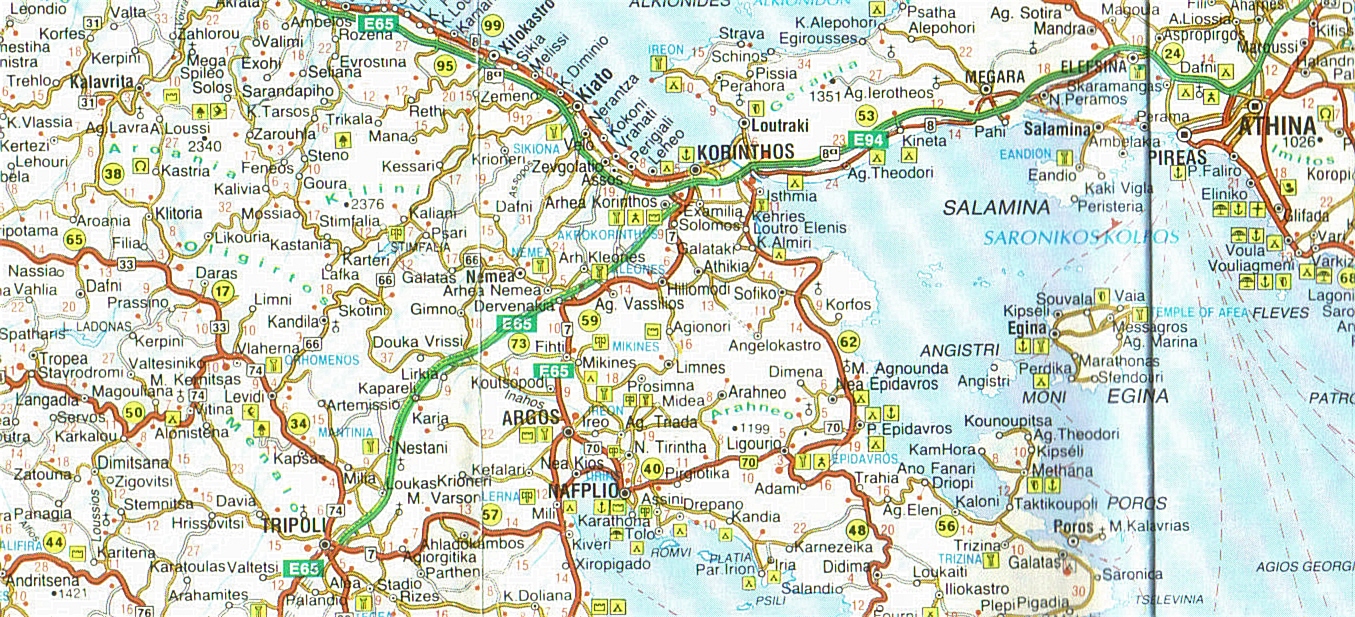 |
| Road Map: Langadhia to Athens |
|
Scooted off pretty early and headed for Tripoli, where I got some
money out. What a procedure! I had to speak to and deal with 5 different
people before I got my money, and as part of the process I had to be
escorted upstairs to a different section of the bank. I couldn't help but
notice that the only machinery in the bank seemed to be (1) telephones and
(2) adding machines. There were no computer terminals or any other labour
saving devices. The desks were all piled high with papers. Third world
indeed.
I
should remark that the roads widened almost as soon as I got past
Karkhlou. I was pilled oevr at one stage by some policemen who were
apparently doing some sort of random testing or checking or whatever. I
never found out because they clearly couldn't be bothered trying to
communicate with a foreigner and they rolled their eyes at me and waved me
on. One of them also gestured towards the brakes which were making a nasty
hissing sound. I could only indicate that, yes, I'd heard that too, but
what could I do about it?
|
|
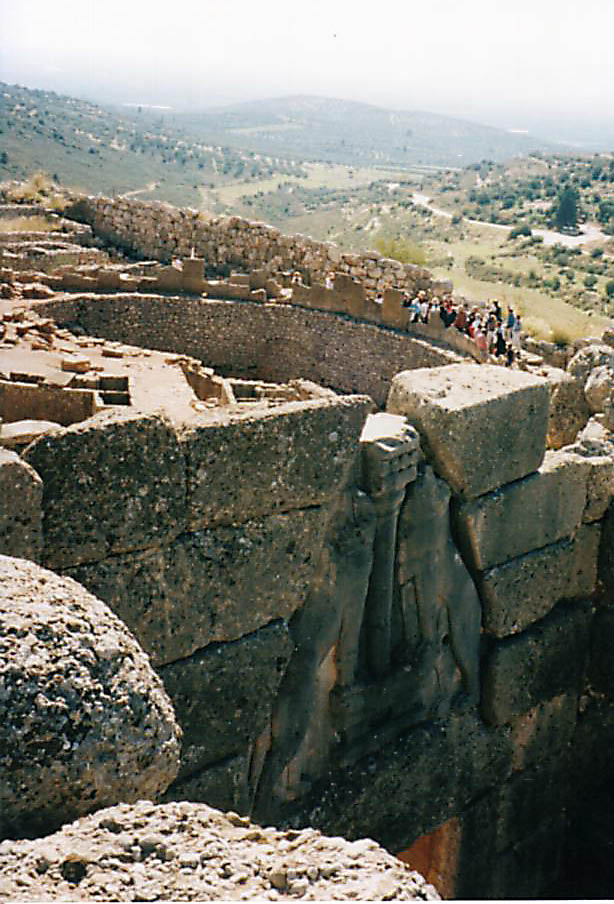 |
|
Mycenae
View of the
Lion Gate. The lions are a monumental version of the emblem of the royal
house of Mycenae (the Atreidae?) Behind it is grave circle A where the
'Homeric' heroes were found by Schliemann. At the upper right is a tour
bus under a tree. It is parked at the entrance to the Treasury of Atreus
(Tomb of Agamemnon.) |
|
Went on to
golden Mycenae. I stopped for brunch in Mikenes, the little
modern village that services the tourist trade there. It was pretty quiet
of course, so I got very personal service from the old lady who was
running the large empty restaurant that I stopped at. The main was a
ghastly, unwhisked omelette, but I also had beer and a coffee and
delicious warm bread. In fact, I asked for extra of that bread and butter,
which she cheerfully supplied.
The ruins were
huge, well excavated, and quite impressive. Especially the lion gate,
although it hasn't come out as well in the photo as I'd have liked. I'd
had high expectations of this site and they weren't disappointed. The Tomb
of Clytemnaestra - a beehive-shaped underground structure - was very
interesting and also impressive: more so than the Tomb of Atreus, I
felt, but that might just be becasue the latter was packed with a rowdy
party of school kids (French or Swiss I think.) They weren't misbehaving,
they were just being kids, but it meant the atmosphere was rather spoiled.
From Mycenae
I went on to Tiryns, a much less obvious site, where there was just
one other person also exploring the ruins. She too was paying close
attention to the maps in her book. I suppose she was doing just the same
sort of tour as I was, and if I'd had more courage I would have approached
her - but we probably couldn't have spoken to each other anyway.
|
|
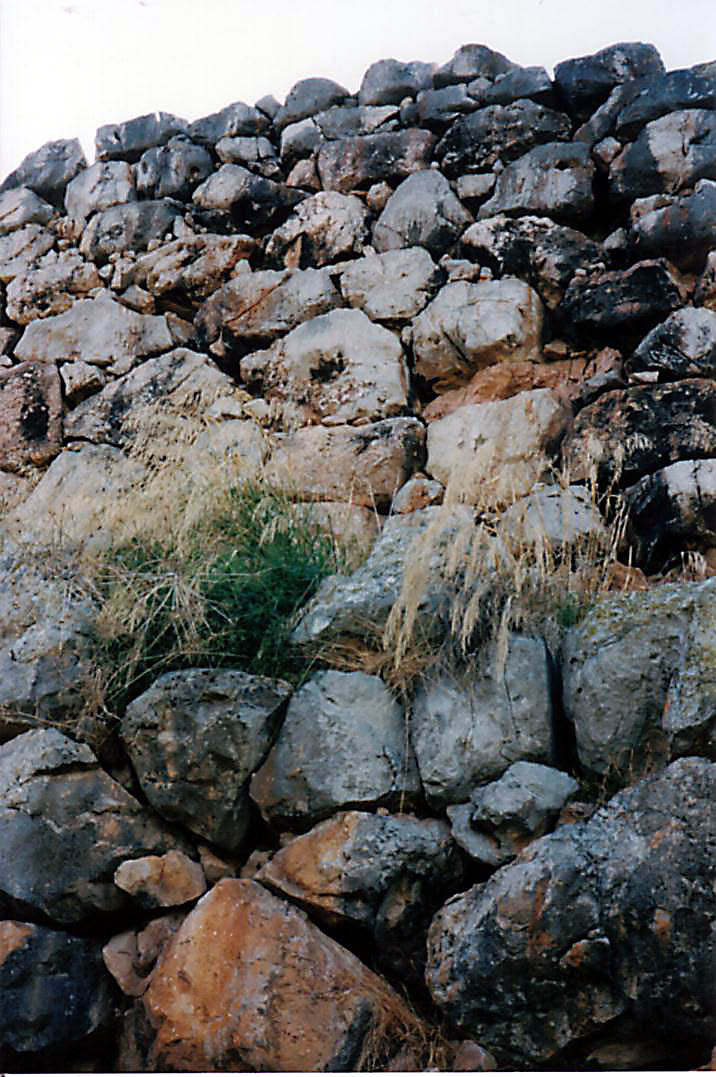 |
|
The Great
Walls of Tiryns
The stones
are positively cyclopean - their height is a good fraction of the length
of a person - and the wall seems to hang over your head when you stand
below it. The effect is not well captured by a photograph.
|
|
 |
|
Epidauros
In the
shadowed centre of the theatre is a tour leader demonstrating the
remarkable acoustics by dropping a penny on the ground. It was perfectly
audible.
|
|
On
to Epidaurus. The temples were pretty ho-hum, but the stadium had
an impressive sense of decay, because it was still recognisable even
though the stones were fallen down and rolling away. Ruins generally are
unrecognisable. The Theatre was brilliant, of course. It was unfortunate
that the same bunch of school kids who had been a plague in Mycenae
had now arrived here. They seem to be making good time!
I
left there with the car sounding more and more sick and headed past
Corinth intending to stop at Megara. Unfortunately that was a
hideous brown industrial dump and I couldn't find anywhere there that I'd
be prepared to stay, so I drove on at terrifying speed in the dark to
Eleusis. Again, what a dump, but I'm in a hotel, the Melissa,
just past the site. I thought I'd get the chance to pop in the next day,
but that didn't happen. I watched 'Sleepless in Seattle' on the TV.
The place was actually a bit strange. The bathroom was all tiles with neon
lights and somehow it felt and sounded just like the room in the final
scenes of '2001: A Space Odyssey'.
|
|
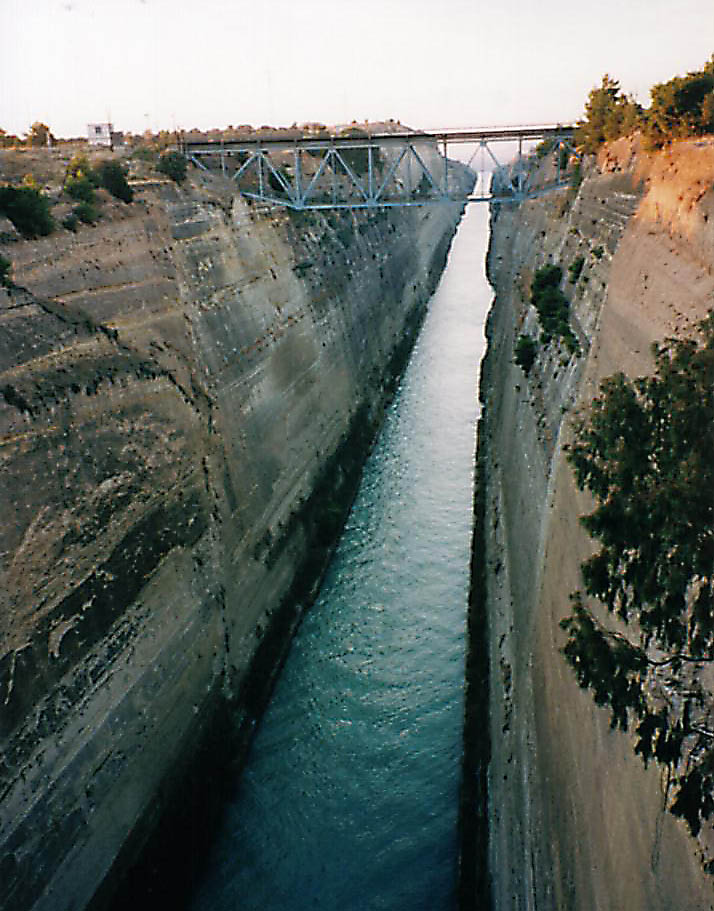 |
|
The Corinth Canal
So narrow. On
the other side a ship was going through and not missing the sides by much
at all.
|
|
7/11/1996
(Thursday) |
|
|
 |
|
Map of Athens |
|
Arrived in ATHENS
in
peak hour, I think. The only signs I saw were for Omonia, and although I
considered leaving the route and trying to find signs for, say, the
acropolis, I gave that up as hopeless. Somehow I drove directly to Iokasta
Travel - which pleased me immensely - and I dropped off the car there.
They booked the Balaska for me (just up the road) and the rental
guy gave me a lift to it. He didn't seem at all fazed by the dreadful
noises that the brakes and the steering were now making.
There's a great view from my hotel roof somewhere behind all the smog. I
could barely make out the Parthenon, even though it should be easily
visible from this distance. Walking along the streets I kept finding
myself adopting an expression of holding my nose away. Athens stinks. I
walked over a fair sample of the city and it all seems to be a dirty,
tatty, stinking slum. I will remember the road system, the pedestrians,
the drivers, as stupid, slovenly, fat and ugly. It is an ugly, ugly place.
I never want to come back here. When I returned I felt dirty, and I was
dirty. In general the Greeks (the Athenians anyway) are totally
disorganized and lacking all good taste. Even the women had no idea about
how to dress. The current city fashion seems to call for large women to
wear tight tops over torpedo-shaped too-small bras. It was an offense to
the eyes. Why doesn't their plumbing work? Why does it take ž hour to get
a cash advance? Etc. Well, enough of that.
I
visited the Archaeological Museum. This had a vast acreage of stuff from
many periods, and I spent quite a while here. Outstanding, I thought, were
the statue of Poseidon, and the treasures of Mycenae. I saw the 'Tripod
Tablet'! There were also plenty of 'melanomorph' and 'erythraeomorph'
ceramics. (I don't think I've ever seen them described with those words
before.) Finally, there were the 'Fleet Frescoes' from Thera. Just
beautiful.
I
also went to the Cycladic Museum. It was small and not very special as far
as the exhibits went - of course, that isn't really my area of interest,
so perhaps I misjudge it - but it was very informative and well set out. A
pleasant surprise.
|
|
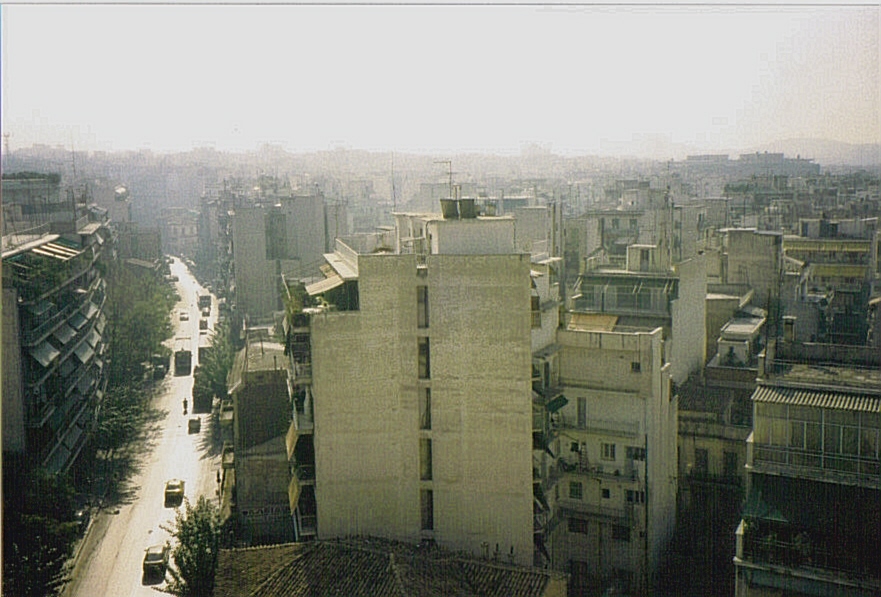 |
|
View of Athens
From my hotel
roof looking towards the Acropolis. It may be one of those fuzzy shapes
out there. |
|
I
walked through Sintagma (Constitution Square), which is supposedly the
city's heart, but it appeared to be a tip. From there I walked through the
National Gardens, which was overrun with feral cats and smelt much as
you'd expect it to. At last I arrived at the Acropolis, which is a
building site at the moment, and has been, apparently, for quite some
time. It was very difficult to get a good angle for a photo of anything.
In fact, only one of the photos turned out to be really usable. That's a
pity, I guess, but it's not as if I don't have plenty of other
(professionally done) pictures of the place. I wandered over this site for
a while (mind the slippery marble) - still, I was pleased to find, in
relative seclusion - until it became fairly late and I had to begin to
walk home. I went via the Areopagus and the Pnyx (to the left of the
bottom of the map shown.) I had some trouble getting out of the grounds
and wound up climbing over a fence near a large locked gate. There seemed
to be no signs for an exit - or the exits really were all locked up by
that time. By the time I got back I was very happy to be in my hotel.
|
|
 |
|
The Parthenon
|
|
8/11/1996
(Friday) |
|
|
At about half
past midnight 'today', other tourists began to arrive in the neighbouring
rooms, and they then began singing. At first I was a bit annoyed by this,
but I think they must have been some sort of trained group, because the
singing was really very good. That was actually a very nice way to go to
sleep.
Up at 5am,
packed and caught a taxi to the airport. As a final gift from Athens the
taxi driver drove like a complete idiot: he was racing the other taxi
drivers at the lights and got up to about 120 in the city. Left Athens
(won't miss it,) and flew home to Wellington via Heathrow #4, Heathrow #3,
and Auckland. My appreciation of the modernity and cleanliness and order
of Wellington has never been greater - but I'm sure that will pass. |